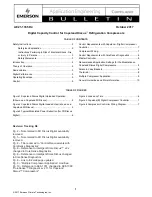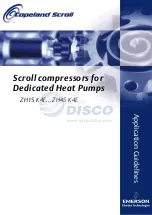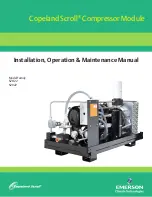
6
Chapter 1
the original equipment manufacturer’s service
information.
Overcharging the system immerses the com-
pressor motor, piston, connecting rods, and
cylinders in liquid refrigerant. This creates a
hydraulic block preventing the compressor
from starting. The hydraulic block is also
known as locked rotor.
Continued supply of electricity to the system
causes heat to build in the compressor. This
heat will eventually vaporize the refrigerant
and rapidly increase system pressure. If, for
any reason, the thermal protector fails to open
the electrical circuit, system pressure can rise
to high enough levels to cause a compressor
housing explosion.
VIII.
Prevention of Water-Utilizing
System Explosions
In certain water-utilizing refrigeration systems,
water can leak into the refrigerant side of the system.
This can lead to an explosion of system compo-
nents, including but not limited to, the compressor.
If such an explosion occurs, the resulting blast can
kill or seriously injure anyone in the vicinity.
A.
Systems at Risk of Explosion
Water-utilizing systems that have single-wall heat
exchangers may present a risk of explosion. Such
systems may include:
•
water source heat pump/air conditioning sys-
tems, and
•
water cooling systems, such as icemakers, water
coolers, and juice dispensers.
Water-utilizing systems that have single-wall heat
exchangers present a risk of explosion unless they
have either:
•
a high pressure cut-out which interrupts power
to ALL leads to the compressor, or
•
an external pressure relief valve.
B.
How an Explosion Occurs
If the refrigerant tubing in the heat exchanger devel-
ops a leak, water can enter the refrigerant side of the
system. Water entering the refrigerant side can come
in contact with live electrical connections in the
compressor causing a short circuit or a path to
ground. When this occurs, extremely high tempera-
tures can result. The heat build-up creates steam
vapor that can cause excessive pressure throughout
the entire system. This system pressure can lead to
an explosion of the compressor or other system
components.
C.
Service Procedures
In light of the risk of explosion, be especially alert
for signs of water leaking into the refrigerant side of
the system. Whenever servicing or troubleshooting a
water-utilizing system, always check to see if it has
either a pressure relief valve or a high pressure cut-
out as previously described. If the system does not
have at least one of these, DISCONNECT ALL
ELECTRICAL POWER and look for indications
that water has leaked into the refrigerant side of the
system. These indications may include:
•
Observation of or a report of a blown fuse or
tripped circuit breaker.
•
Signs that water has leaked to the outside of the
system.
•
Reports that the system has made gurgling or
percolating noises.
•
A history of loss of refrigerant charge without a
leak being found in the system. NOTE: Com-
mon leak detection methods will not detect a
water-to-refrigerant leak in the system’s heat
exchanger(s).
•
Observation of or a report of the compressor
giving off an unusual amount of heat.
If ANY of these indications are present, do the fol-
lowing checks to determine if water has leaked into
the refrigerant side:
Step 1:
Check for a Ground Fault (a Short to
Ground).
Check the compressor for a ground fault (also
known as a short circuit to ground) using the proce-
dure outlined in “Identifying Compressor Electrical
Problems” on page 47.








































